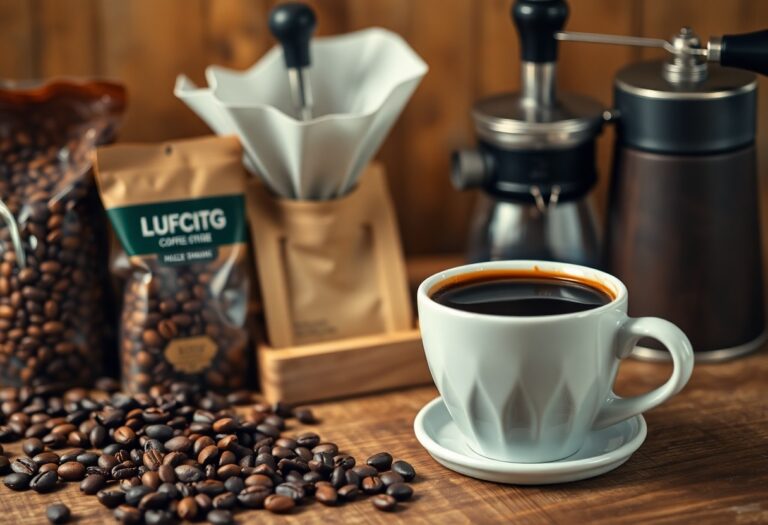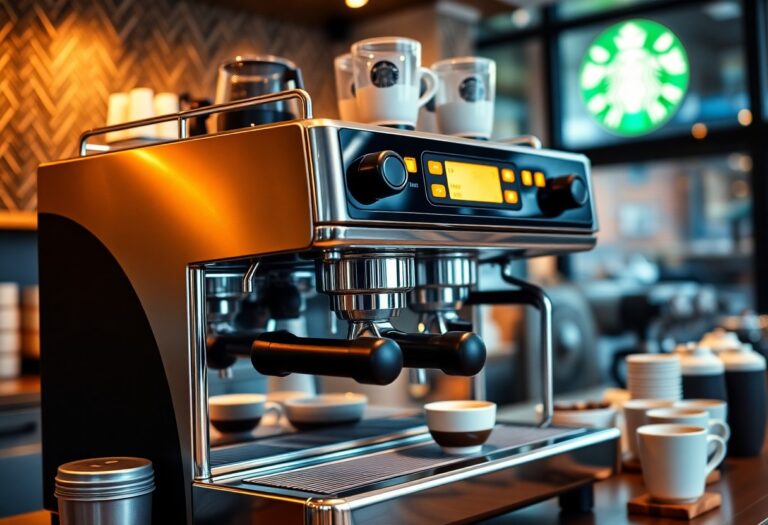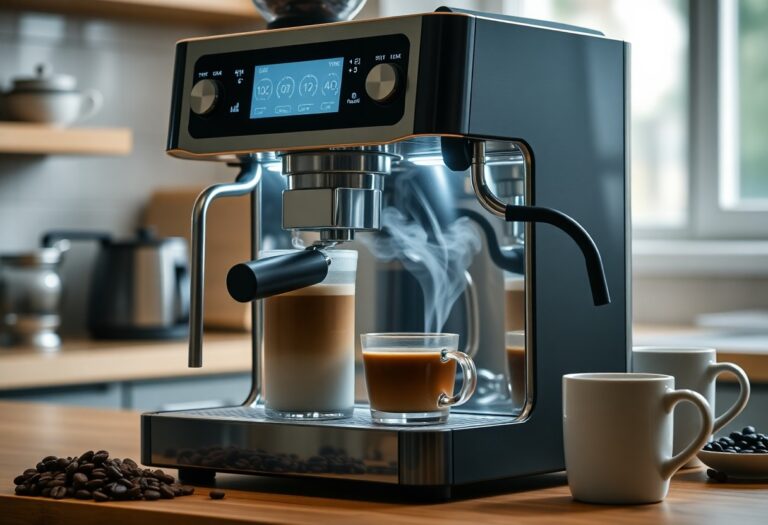What Sound Does a Coffee Machine Make – Audio Characteristics
Just as the aroma of fresh coffee awakens your senses, the sounds produced by your coffee machine can also be quite telling. You’ll notice a range of audio characteristics—from the gentle hum during brewing to the sudden bursts of steam—each sound playing a distinct role in the process. Understanding these sounds not only enhances your coffee-making experience but also helps you detect potential issues or malfunctions that may arise. Join us as we explore the unique auditory world of your coffee machine and what it signifies for your daily brew.

Key Takeaways:
- The sound of a coffee machine varies significantly depending on the type, such as drip, espresso, or single-serve machines.
- Common audio characteristics include boiling water sounds, dripping, gurgling, and hissing noises as steam is released.
- Espresso machines tend to produce more dramatic sounds, including heavy pressure build-up and high-pitched hissing during the brewing process.
- Maintenance can affect sound characteristics; a well-maintained machine will usually operate more quietly than one that requires servicing.
- Electronic and programmable machines may add different beeping or alert sounds that indicate readiness or completion of the brewing cycle.
The Sonic Journey of Brewing Coffee
The experience of brewing coffee is not just about the rich flavors; it is also a captivating auditory spectacle. Each stage of the brewing process generates a distinctive soundscape that reflects the transformation of simple ingredients into your favorite beverage. From the gentle gurgling of water heating in a drip machine to the sharp hiss of steam from an espresso maker, the sounds intricately weave together, creating a unique symphony that marks the beginning of your morning ritual.
The Sound Spectrum: Breaking Down Frequencies
Understanding the sound spectrum of your coffee machine involves identifying the various frequencies at play during the brewing process. High frequencies may come from the steam or bubbling of water, while lower frequencies might resonate from the motor or pumps activating your machine. Each frequency contributes to the overall acoustic profile, giving life to an otherwise silent kitchen.
Decibel Levels: Measuring the Volume of Your Morning Brew
The volume levels produced by coffee machines vary considerably, typically ranging from 50 to 80 decibels. Drip coffee makers tend to hum around 50-60 decibels, while espresso machines can spike higher, sometimes reaching 80 decibels during peak operation. This range places them at a comfortable sound level; generally, you can brew your coffee without disturbing others in your household.
Measuring the decibel levels of your coffee machine can provide insight into its operational efficiency and can even indicate potential maintenance needs. For instance, if your espresso machine starts producing sounds above the typical 80 decibels, this might signal underlying issues like a clogged steam wand or an inefficient pump. Being mindful of these changes not only enhances your coffee experience but also helps you maintain the longevity of your equipment.

Identifying Unique Coffee Machine Sounds
Every coffee machine produces a symphony of unique sounds, each corresponding to specific processes in brewing. By tuning into these audio cues, you can decipher much about your machine’s performance, freshness of the coffee, and even when maintenance might be necessary. Understanding these sounds helps you enjoy a better brewing experience, ensuring each cup is not just flavorful but brewed with precision.
Whirring and Hissing: The Dance of Pumps and Pressures
The rhythmic whirring and hissing of coffee machine pumps signal the movement of water under pressure through the coffee grounds. These sounds highlight the brewing process’s inner workings, where your machine’s pump works tirelessly to create the perfect extraction. You can even tell if your machine is operating efficiently, as abnormal sounds may suggest air leakage or wear and tear.
Gurgling and Dripping: What the Last Drops Tell You
As your coffee machine nears the end of its cycle, the unmistakable gurgling and dripping sounds emerge. These noises are the final throes of water passing through the coffee grounds and into the pot, indicating that your brew is almost complete. The gentle gurgling signifies the release of any residual water lingering in the system. Listening closely can provide insights, as unusually loud gurgling could indicate blockages or brewing inconsistencies.
This gurgling and dripping phenomenon serves as a final reminder that your coffee is ready, but it can also betray hints about your machine’s condition. If you notice sudden changes in volume or pitch, such as a louder gurgle, it may be time for a thorough cleaning or descaling. For example, if your machine is prone to clogs, the last drops can become a frustrating experience, often indicating that the internal pathways need attention. Taking the time to listen can enhance not only your immediate brewing experience but also extend the lifespan of your machine.
Sound and Its Impact on User Experience
The auditory environment created by your coffee machine significantly influences your overall user experience. Sounds can evoke emotions, set the mood, and even trigger memories associated with brewing and enjoying coffee. A harmonious blend of sounds from grinding beans to the gentle bubbling of water can enhance your morning ritual, making it feel more enjoyable and satisfying. Conversely, jarring or inconsistent noises may lead to frustration or distraction, detracting from the simple pleasure of coffee-making.
The Psychological Effects of Coffee Machine Sounds
Coffee machine sounds can elicit various psychological responses that impact your daily routine. For instance, the soothing hum of a grinder or the rhythmic gurgling of brewing can create a calming atmosphere, fostering relaxation and anticipation. Studies suggest that auditory stimuli directly affect your mood and can even boost feelings of happiness and contentment, paving the way for a more pleasant coffee experience. When sounds align with your expectations, they reinforce the ritual, making each cup feel more rewarding.
Soundscapes: Crafting the Perfect Ambience for Brewing
The concept of soundscapes involves creating a carefully curated auditory environment that complements your coffee brewing experience. Incorporating sounds that resonate with your preferences can enhance the overall ambiance, making the process feel more immersive. For example, pairing the sounds of your coffee machine with soft background music or nature sounds can transform your kitchen into a serene cafe-like atmosphere, allowing you to savor every moment of your brewing ritual.
To effectively craft your ideal brewing soundscape, consider playing gentle jazz, acoustic melodies, or even ambient soundtracks while your coffee machine works its magic. The gentle interplay of machine noises and harmonious music not only masks any unpleasant sounds but also promotes relaxation and enjoyment. Experimenting with different audio elements can help you find the perfect blend that elevates your coffee moments, transforming an everyday task into a delightful sensory experience.
Comparing Coffee Machine Audio Profiles
Understanding the audio characteristics of various coffee machines allows you to appreciate the subtle differences in their performance. By comparing these sounds, you gain insight into their functionality and brewing methods. Below is a brief overview of two primary types of coffee machines and their respective audio profiles:
| Coffee Machine Type | Audio Characteristics |
|---|---|
| Espresso Machines | Distinct hissing and buzzing sounds, often accompanied by the pressure release during brewing. |
| Drip Coffee Makers | Gentle gurgling and dripping sounds, creating a more soothing audio experience. |
Espresso Machines vs. Drip Coffee Makers: A Sonic Comparison
The sound profiles of espresso machines and drip coffee makers exhibit stark contrasts that reflect their brewing techniques. Espresso machines typically generate loud bursts of pressure and steam, delivering an energetic auditory experience that’s synonymous with café culture. In contrast, drip coffee makers produce a softer and more tranquil symphony of sounds, creating a calming atmosphere ideal for leisurely mornings. These audio characteristics contribute to the overall enjoyment of your coffee ritual.
The Silent Heroes: Innovations in Quiet Brewing Technology
Recent advancements in brewing technology have led to quieter coffee machines, allowing you to enjoy your morning cup without jarring noises. Many companies now employ sound-dampening materials and innovative pump designs that significantly reduce operational noise. For instance, some high-end espresso machines feature advanced motor designs that minimize vibration, fostering an environment conducive to calm and focus. These innovations not only enhance your daily coffee experience but also cater to those who appreciate peace in their brewing rituals.
Harnessing Coffee Machine Sounds for Innovation
Innovative coffee machines go beyond brewing delicious coffee; they are now blending audio elements into the user experience. By utilizing the unique sounds generated during brewing, manufacturers can create machines that not only provide sensory enjoyment but also offer interactive features. These audio cues can signal specific phases of the brewing process, allowing you to anticipate when your cup of joe is ready, enhancing your overall coffee ritual.
Integrating Audio Feedback in Smart Brewing Devices
Smart brewing devices increasingly integrate audio feedback to enrich your coffee-making experience. For instance, certain machines employ sounds such as beeps, chimes, or melodic cues to indicate the completion of various tasks. This approach not only makes the process more engaging but also keeps you informed without having to interrupt your routine or check visually.
The Future of Sound Design in Coffee Culture
Sound design within coffee culture is evolving as technology advances. Future developments could invlove personalized audio experiences, where your coffee machine learns your preferences and creates a unique auditory blend to accompany your brewing. Imagine the soothing sounds tailored to your taste preferences, transforming your home brewing zone into a personalized auditory oasis that enhances enjoyment.
The infusion of sound design into coffee culture presents vast potential for enhancing the user experience. Some brands are already experimenting with soundscapes that align with different coffee types or brewing methods. For instance, a slow pour-over might incorporate gentle water sounds, while an espresso machine could feature sharp, energizing beeps. As sensory research progresses, expect coffee makers to adapt auditory feedback that resonates with your emotional state, fundamentally changing how you enjoy your coffee ritual.
Final Words
With these considerations, you’ll have a clearer understanding of the audio characteristics a coffee machine produces during its operation. The sounds—from the initial water heating to the bubbling and dripping—provide insight into your machine’s functionality. If you’re curious about the reasons behind these noises, you can explore why do coffee makers make noise when you turn them on? Understanding these sounds not only enhances your brewing experience but also helps you troubleshoot any issues that may arise.
FAQ
Q: What sounds does a coffee machine typically produce during the brewing process?
A: During the brewing process, a coffee machine commonly produces a series of sounds. Initially, you may hear a humming noise which indicates the pump is working to move water through the system. As water heats up, bubbling or gurgling sounds can emerge, especially if the machine has a pressurized system. Once brewing is complete, a soft hissing may occur when steam is released, particularly in espresso machines.
Q: Are there different sounds for different types of coffee machines?
A: Yes, various coffee machines have distinct audio characteristics based on their design and function. Drip coffee makers usually emit a consistent dripping or trickling sound as water passes through the coffee grounds. Espresso machines often add high-pitched whirring and hissing due to the steam pressure involved. French presses or pour-over methods are quieter, only producing sounds associated with pouring hot water.
Q: Why do some coffee machines sound louder than others?
A: The noise level of a coffee machine can vary due to several factors including build quality, materials used, and the design of the internal components. More affordable models might incorporate less effective noise insulation, leading to louder operation. Conversely, high-end machines might be built with quieter motors and pumps that minimize sound output, providing a more subdued brewing experience.
Q: Can the sounds a coffee machine makes indicate a problem?
A: Yes, unusual sounds from a coffee machine can signal underlying issues. For instance, if you hear excessive grinding or rattling, it could suggest that the grinding mechanism is jammed. Gurgling sounds paired with slow brewing might indicate a blockage in the water lines. It’s advisable to consult the user manual or contact support if unfamiliar sounds persist.
Q: How can I reduce the noise from my coffee machine?
A: To reduce noise levels from a coffee machine, consider placing it on a rubber mat or anti-vibration pad, which can help absorb sound. Ensure the machine is on a stable surface to avoid unnecessary rattling. If possible, choose a coffee maker designed with noise-reduction features and soundproofing materials. Regular maintenance, including cleaning and descaling, can also help keep it running smoothly and quietly.







